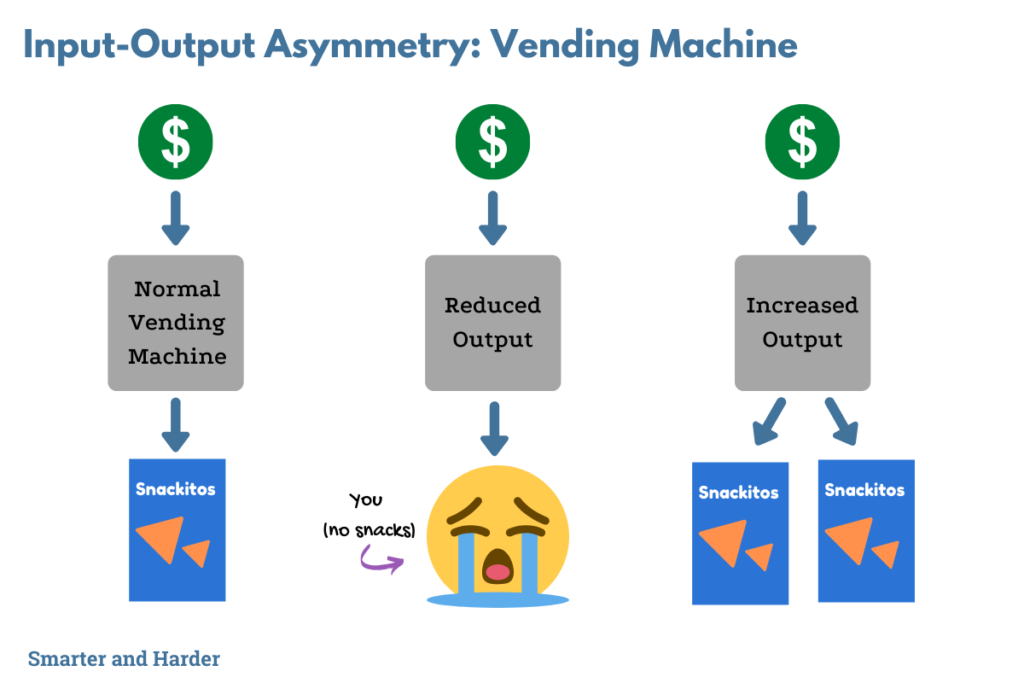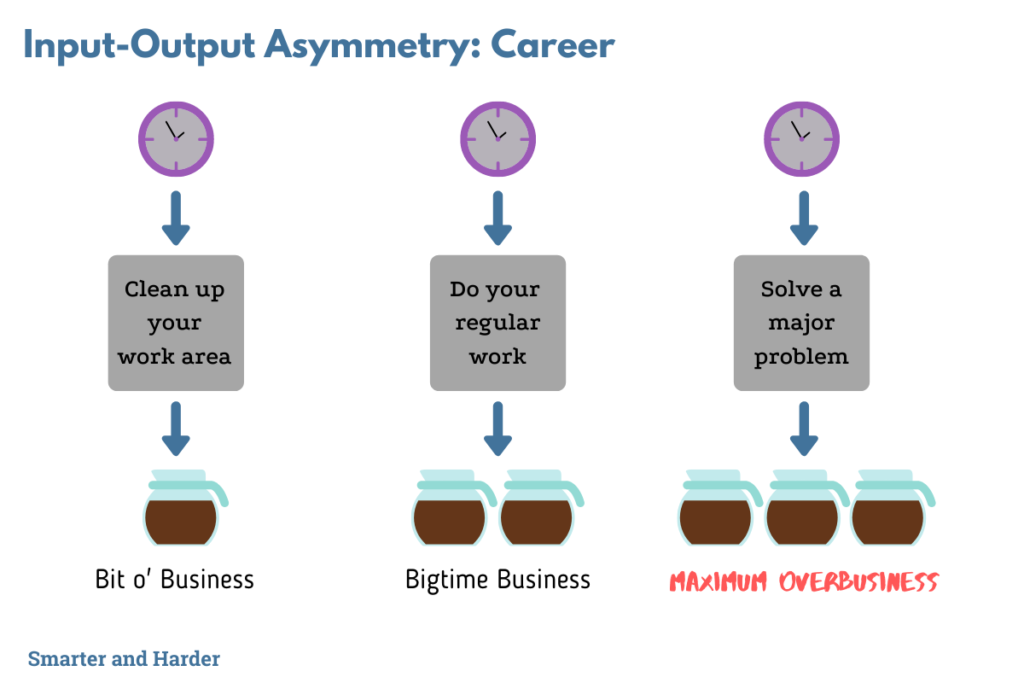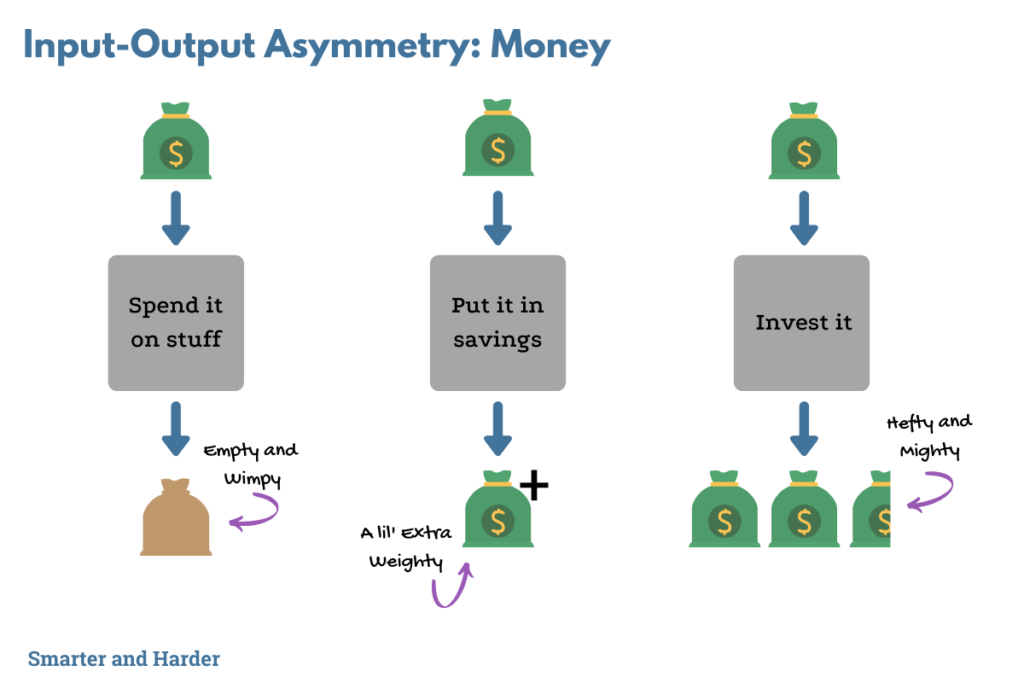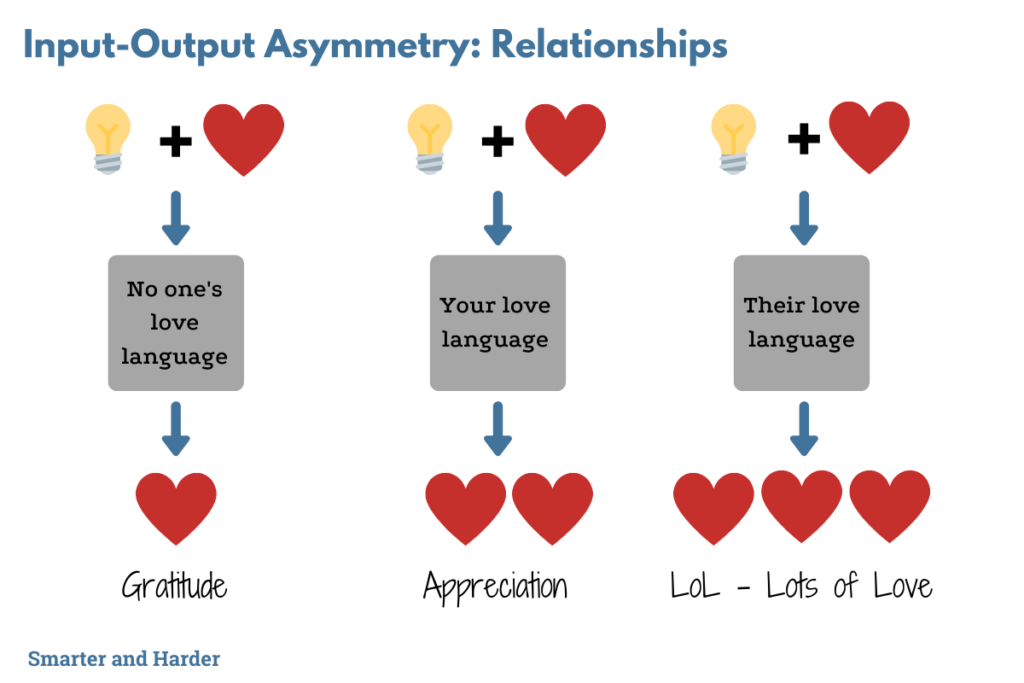Whether you know about it or not, input-output asymmetry can transform your life choices. It’s a deciding factor in whether you fall short of your goals, reach them, or shoot clean past them and land somewhere new entirely.
And yet most people have never even heard of it. So what is it?
Have you ever put a dollar into a vending machine and pressed E6 for the Cool Ranch Doritos, then looked on in despair as your snack got stuck in the machine, robbing you of all that is good and salty in the world?
Alternatively, have you ever put a dollar into a vending machine and pressed E6 for the Cool Ranch Doritos, then looked on in salacious delight as not one but two bags fell, unequivocally crowning you the new king/queen of the cool delightful ranch flavor kingdom?!
In both cases, what you experienced is input-output asymmetry.

Typically when you put one dollar into a vending machine, you get one dollar’s worth of snacks. But there are some cases, like the above, where the output is asymmetrical to the input. Sometimes one dollar of input can result in zero dollars’ worth of output or two dollars’ worth.
Input-output asymmetry is a fancy-sounding phrase that describes the natural imbalance between what you put into a situation and what you get out of it. And we can harness this concept and use it to push us forward.
How Can We Leverage Input-Output Asymmetry?
The input-output ratio is out of your control in the vending machine example. Vending machines are mysterious and unpredictable; only the gods can know their will. You get what you get and hope for the best.
But what if we were more able to predict the output? What if there was one vending machine that never gave you your snack and an otherwise identical one that always paid out double? Which one would you use?
Efficiency like this is 90% figuring out what you’re not going to do and 10% deciding what you will do. It’s all about separating the messiness of life from the few critical objectives that blast you toward the place you want to be. And input-output asymmetry is a device you can use to figure out that essential 10%.
When it comes to some of the major priority areas in life, like your career, health, relationships, and money, there are abundant opportunities for input-output asymmetry if you know how to look for them.
And the reward, in those cases, turns out to be far greater than an extra bag of chips and the unanimous envy of your unlucky, one-bag-of-Doritos-having peasant friends.
The reward is a new outlook on life and a dramatically improved roadmap to your goals.
See It in Action
Let’s look at some examples where you can consciously and reliably take advantage of input-output asymmetry and use it to set yourself on a new trajectory. Below are examples of input-output asymmetry in three significant areas of life that contribute to our happiness: career, money, and relationships.
Input-Output Asymmetry In Your Career
Hard work alone seldom leads to professional success. It’s undoubtedly an essential part of the recipe, but not by itself. You can’t just pick up any work, do it as hard as possible, and eventually become the CEO.
What you work on matters just as much as how hard your work on it, if not moreso.
Imagine deciding how to spend the next 1 hour of work today:
Scenario 1: Cleaning up your workspace
Input: 1 hour of work
Output: (Low) Your upcoming tasks will be slightly less scattered
Scenario 2: Do your regularly assigned work
Input: 1 hour of work
Output: (Moderate) Tasks get done and your superiors are satisfied
Scenario 3: Find a new solution to a problem
Input: 1 hour of work
Output: (Huge) A large impact on future work, recognition from your superiors, plus appreciation and respect from your peers

Choose carefully where you put your professional energy, and then work as hard as you can on those things. The people who you see constantly progressing in their careers understand this. It’s not that they are more intelligent than you or that they work harder or get luckier. Instead, they carefully choose their battles for maximum results.
Input-Output Asymmetry With Your Money
One of the greatest and most common misconceptions about wealth is that it’s all about your income. In reality, that’s a pretty small piece of the equation.
In building wealth, it matters very little how hefty your paycheck is and far more what you do with your money once it does come in. If you make $10 million a year and spend $10 million a year, you’re just about as well-off as someone who didn’t make a dime.
What it comes down to, then, is how best do we apply our money to build for the future?
Imagine you have just received $100 and need to decide what to do with it:
Scenario 1: Buy Cool Ranch Doritos
Input: $100
Output: (Low) Roughly one hundred bags of chips, and no money left over in ten years
Scenario 2: Put it in savings
Input: $100
Output: (Moderate) All your money left over after ten years, plus about $10 in interest
Scenario 3: Invest it in a reliable index fund
Input: $100
Output: (Huge) Roughly $260 total after ten years, nearly tripling your input through compound interest

If you want more money down the road than you have right now, think about how you put each of your dollars to work today and how you can use input-output asymmetry to multiply their value.
But it’s not all just graphs, dollar signs, and power-business — Input-Output asymmetry can be used as a lever to bolster your soft skills, too.
Input-Output Asymmetry In Your Relationships
Whether romantic, social, or professional, you’ll do significantly more for all of your relationships when you seek to understand yourself and the other person before you act. What matters most to you may not seem as big a deal to them, and vice versa.
Gary Chapman’s “Five Love Languages” are one extremely helpful framework for understanding these differences, though there are many others.
Consider an example where your love language is words of affirmation, and your friend’s love language is gift giving. Imagine that friend is having a hard day, and you are trying to choose a thoughtful thing you could do for them:
Scenario 1: Help your friend around the house (love language: acts of service)
Input: A kind thought and a nice gesture
Output: (Low) Being thoughtful, while speaking neither of your love languages, helps a little bit
Scenario 2: Write your friend a kind note (love language: words of affirmation)
Input: A kind thought and a nice gesture
Output: (Moderate) Speaking your own love language, you will be able to put more into it, and your friend will feel appreciated
Scenario 3: Pick your friend a flower that made you think of them (love language: gifts)
Input: A kind thought and a nice gesture
Output: (Huge) Speaking their love language, even in a small way, makes your friend feel more loved, and lifts them up

Putting in thought and effort is essential to the success of any relationship. In figuring out just what sort of effort to put in, a little extra thought is a great way to use input-output asymmetry to strengthen your relationships, benefiting everyone involved.
Identify Your Input-Output Asymmetry Opportunities
These are just a few examples, but this trend is everywhere, and there are countless opportunities to take advantage of it for success, happiness, and achievement of all sorts.
When you want to work Smarter, get more done, and achieve bigger goals, use this as one of your tools. Search for where the opportunities are. Know that just like vending machines, not all situations are created equal. Some can offer far greater reward for less input.
You can learn to use input-output asymmetry to get better results in every area of your life. All it takes is to consider your options before you start and carefully decide which way to go.


A very interesting write-up! Love the perspective 😀
Thanks, I’m glad you enjoyed it!
This is a challenging concept to wrap the head around – the illustrations really break it down nicely. Great piece of work!
Glad you like it, we’ve been putting a lot of energy into our visuals and infographics (if you can call them that) around here lately!